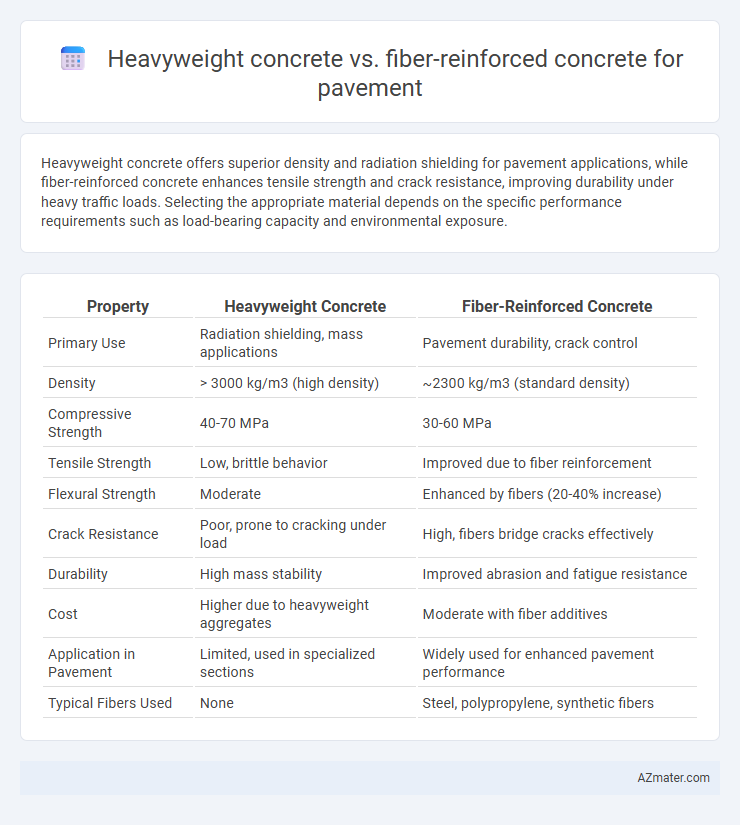Heavyweight concrete offers superior density and radiation shielding for pavement applications, while fiber-reinforced concrete enhances tensile strength and crack resistance, improving durability under heavy traffic loads. Selecting the appropriate material depends on the specific performance requirements such as load-bearing capacity and environmental exposure.
Table of Comparison
| Property | Heavyweight Concrete | Fiber-Reinforced Concrete |
|---|---|---|
| Primary Use | Radiation shielding, mass applications | Pavement durability, crack control |
| Density | > 3000 kg/m3 (high density) | ~2300 kg/m3 (standard density) |
| Compressive Strength | 40-70 MPa | 30-60 MPa |
| Tensile Strength | Low, brittle behavior | Improved due to fiber reinforcement |
| Flexural Strength | Moderate | Enhanced by fibers (20-40% increase) |
| Crack Resistance | Poor, prone to cracking under load | High, fibers bridge cracks effectively |
| Durability | High mass stability | Improved abrasion and fatigue resistance |
| Cost | Higher due to heavyweight aggregates | Moderate with fiber additives |
| Application in Pavement | Limited, used in specialized sections | Widely used for enhanced pavement performance |
| Typical Fibers Used | None | Steel, polypropylene, synthetic fibers |
Introduction to Heavyweight and Fiber-Reinforced Concrete
Heavyweight concrete incorporates high-density aggregates such as barite, magnetite, or hematite, enhancing mass and radiation shielding properties, making it ideal for specialized pavement applications requiring durability under heavy loads. Fiber-reinforced concrete integrates synthetic, steel, or natural fibers to improve tensile strength, crack resistance, and overall toughness, effectively mitigating surface wear and extension of pavement lifespan. Both types are engineered to address distinct structural demands, with heavyweight concrete emphasizing load-bearing capacity and fiber-reinforced concrete focusing on enhanced flexibility and crack control.
Composition and Material Properties
Heavyweight concrete incorporates heavyweight aggregates such as barite, magnetite, or hematite, resulting in a density typically above 3000 kg/m3, which enhances its radiation shielding and load-bearing capacity for pavement applications. Fiber-reinforced concrete integrates discrete fibrous materials like steel, glass, or synthetic fibers to improve tensile strength, crack resistance, and durability without significantly increasing density, optimizing toughness and impact resistance. Material properties of heavyweight concrete emphasize high compressive strength and radiation attenuation, while fiber-reinforced concrete focuses on flexural strength and post-crack performance, influencing pavement longevity and maintenance requirements.
Strength and Durability Comparison
Heavyweight concrete offers superior compressive strength and density, making it ideal for high-impact pavement applications requiring enhanced load-bearing capacity and radiation shielding. Fiber-reinforced concrete improves tensile strength and crack resistance through the distribution of synthetic or steel fibers, enhancing durability against fatigue and shrinkage-related damage in pavement. Both materials provide distinct benefits, with heavyweight concrete excelling in static load durability, while fiber-reinforced concrete delivers better performance under dynamic and flexural stress conditions.
Load-Bearing Capacity Analysis
Heavyweight concrete demonstrates superior load-bearing capacity due to its high-density aggregates, which provide enhanced compressive strength ideal for heavy traffic pavements. Fiber-reinforced concrete improves load distribution and crack resistance by incorporating synthetic or steel fibers, reducing fatigue damage under repeated traffic loads. Comparative studies reveal that heavyweight concrete supports greater static loads, while fiber-reinforced concrete excels in dynamic load durability and impact resistance for pavement applications.
Crack Resistance and Flexural Performance
Heavyweight concrete exhibits superior crack resistance due to its dense matrix and increased compressive strength, making it ideal for high-load pavement applications. Fiber-reinforced concrete enhances flexural performance by distributing tensile stresses through embedded fibers, effectively preventing crack propagation and improving durability under bending forces. Combining heavyweight aggregate materials with fiber reinforcement results in pavements with enhanced structural integrity and prolonged service life.
Construction Methods and Workability
Heavyweight concrete for pavement typically requires specialized batching and handling due to its dense aggregates, which can affect placement and compaction methods. Fiber-reinforced concrete enhances workability by reducing segregation and improving mix stability, allowing easier finishing and better resistance to cracking during curing. Construction with fiber-reinforced concrete often enables faster placement and reduced need for joint sealing compared to heavyweight concrete, improving overall pavement durability and lifecycle performance.
Maintenance and Lifecycle Costs
Heavyweight concrete offers superior durability and load-bearing capacity for pavements, reducing the frequency of maintenance but often entails higher initial material costs compared to fiber-reinforced concrete. Fiber-reinforced concrete enhances crack resistance and improves tensile strength, leading to lower repair costs and extended service life by minimizing pavement deterioration. Lifecycle cost analysis typically favors fiber-reinforced concrete due to decreased maintenance interventions and prolonged pavement performance despite its moderately higher upfront expense.
Environmental Impact and Sustainability
Heavyweight concrete, primarily composed of dense aggregates like barite or magnetite, increases pavement durability but often involves higher embodied energy and resource extraction impacts compared to fiber-reinforced concrete. Fiber-reinforced concrete enhances crack resistance and extends pavement life while allowing for reduced material thickness, which can lower carbon emissions and resource use during production and installation. Sustainable pavement design favors fiber reinforcement due to its ability to improve longevity and reduce maintenance frequency, minimizing environmental footprints over the pavement lifecycle.
Suitability for Different Pavement Applications
Heavyweight concrete offers superior density and radiation shielding, making it ideal for pavements in nuclear power plants and medical facilities where radiation protection is critical. Fiber-reinforced concrete enhances tensile strength, crack resistance, and durability, proving well-suited for high-traffic highways, airport runways, and industrial pavements subjected to dynamic loading and thermal stresses. Selecting between heavyweight and fiber-reinforced concrete depends on specific pavement performance requirements, environmental conditions, and structural demands.
Conclusion: Selecting the Optimal Concrete for Pavement
Heavyweight concrete offers superior density and radiation shielding, making it ideal for specialized pavement applications requiring durability and protection, while fiber-reinforced concrete enhances tensile strength, crack resistance, and durability under dynamic loads. Selecting the optimal concrete depends on the specific pavement requirements: heavyweight concrete suits high-impact, heavy-load environments, whereas fiber-reinforced concrete is advantageous for improving longevity and reducing maintenance in conventional traffic conditions. Considering factors such as load intensity, environmental exposure, and desired lifespan ensures an informed choice between heavyweight and fiber-reinforced concrete for pavement construction.

Infographic: Heavyweight concrete vs Fiber-reinforced concrete for Pavement
 azmater.com
azmater.com